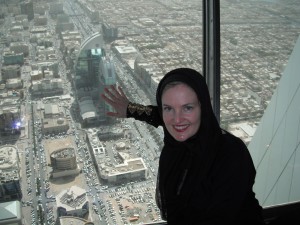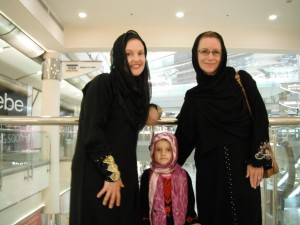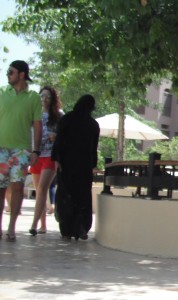This Girl in Riyadh
When we were planning our trip to Saudi Arabia, I knew from guidebooks that I’d have to wear an abaya (dark robe) over my clothes to cover any hint of feminine curves. I’d also have to wear a black veil over my hair, ears, neck. I was prepared for this, even went shopping at Amman’s Mecca Mall and picked out an abaya that snapped up the front and had rhinestones on the gold-velvet sleeves, as well as a black Kuwaiti headscarf that squeezed my face through a small hole and felt suggestive of strangulation whenever I wore it. But I was excited to don this gear in Riyadh, for both the costume appeal and the odd anonymity of it, but most of all to get a glimpse of what it felt like for millions of women who cover themselves in such a way every day.
However, I was not prepared for Saudi Arabia’s segregation between men and women. I didn’t realize that our very nice Sheraton Hotel would not allow me to swim in the hotel pool. Or go to the main gym on the first floor. Instead, I had to use the small women’s gym on the fourth floor with it’s two elliptical machines and a stationary bike. Even Starbucks would not allow my friend, Katie Monge, and I to sip in the main area, instead directing us to go through the frosted-glass automatic doors and sit inside wooden cubicles, lest someone see us with suggestive cappuccino foam on our lips. At this point we started to re-examine our guidebook, realizing that many of the restaurants we had circled with enthusiasm (baby camel anyone?) had the words Men Only in tiny italics near the operating hours, and that the museums had “Family Hours” (the euphemism for “Hours in Which Women are Allowed Entrance”) only in the late afternoon.
It seemed a little bleak for we women at first, especially since mine and Katie’s husband had meetings at the American Embassy at Riyadh for a couple of days. We ladies were left stranded at the hotel (it was also recommended that women not take cabs without a male escort, and the only thing within walking distance was a mall that didn’t open until 4 p.m.). Outraged, I filled out a hotel comment card in capital letters, letting the Concierge know how upset I was about not being to swim with my four-year old daughter. A few minutes later, I was amazed and a little abashed to find the Concierge knocking at my room door and handing me toys for my sequestered child to play with.
This would be my emotional reaction to everything: at first my American sensibilities were frustrated at a situation and I would get all fiesty about perceived injustices. But a moment later I would glimpse the Saudi solution, and while not always perfect, I realized that I had to try to think outside my veil.
I was peeved that there wasn’t one treadmill in the women’s miniscule gym (my husband told me there was an entire wall of treadmills in the main/male gym on the first floor). Yet I couldn’t help but appreciate having the women’s mirrored-room to myself, using the free weights without worrying that grunting men in lifting belts were going to smirk at my sissy eight-pounders held shakily aloft.
I was annoyed we had to eat our Taco Bell in the family seating area (ahem, yes, we were in Saudi Arabia and our first stops were Starbucks and Taco Bell, but no one was in the mood to try that aforementioned baby camel…), away from all the young men in their white dishdasha robes and flowing red and white checked head scarves who merrily munched at crowded tables right in the center of the action. Yet the “family area” looked out on a wall of windows facing a manicured garden with fake balloons staked to the ground, was sparkling clean and, unlike the men’s section, had plenty of open tables to choose from.
Though we were supposed to be accompanied by a male member of our family at all times, Katie and I happened upon a “Ladies’ Kingdom” floor of the mall only opened to women, where gals took off their veils and unzipped their abayas, drinking coffee in the open, even ignoring the call to prayer (everything in Riyadh, including all the shops in the malls, closes for about 30 minutes during each of the day’s five calls to prayer). The women of the Ladies’ Kingdom certainly did not seem like a meek or submissive lot.
During our tour of The Gulf, we’d attended some deliberate educational events, including a lunch at the Dubai Culture Center. A man lectured while we ate the local spread, and since he was a man, and since he was a man wearing white, I was a little skeptical when he claimed, “Wearing a black abaya is like wearing sunglasses—you don’t sweat from your eyelids when you put on your dark sunglasses, do you?” He also said abayas were great when his wife was running out of the house and didn’t want to get “dressed up.”
In Riyadh, I had no choice but to wear the abaya (it is enforced by the religious police, or Mutawa, who supposedly carry around paddles to beat people who commit religious infractions). I might be a little skeptical about the sunglasses theory, but, man, it only took me a couple of hours to fall in love with my abaya. I adored its instant elegance, its flowing length and shining sleeves, especially when I had my non-treadmill-using-gym-clothes hidden underneath. Even my daughter started asking to wear her mini abaya by the end of our trip, willingly wrapping a purple scarf around her blond hair before leaving our hotel room.
Which made me wonder what other presumptions I had made, how many subtle details of dress and culture my untrained American eyes had been missing. Since arriving in Jordan last March, every time I’d see a woman in a black abaya walking down the street I’d feel a flash of irritation, especially if she was walking next to a man in a t-shirt and jeans, wondering how she allowed herself to be made invisible, wiped clean of individual flair, of color and form and identity. But on this Gulf trip of ours (seventeen days in the Sultanate of Oman, United Arab Emirates, and Saudi Arabia), where traditional clothing is worn by both sexes much more often than it is in relaxed Jordan, I saw women wearing black abayas of every shape and style. I couldn’t help but notice the details, the bedazzled cuffs, the embroidered hems, the glint of sequins and metallic threads in the dark veils. Most interesting of all, the women who are completely covered with the niqab, with only the area around their eyes revealed, even these women have found ways to express themselves, sometimes using an intricate knot system at the back of their heads to keep the veil across in place, the cord looped and twisted so that it looks like a braid different than anyone else’s.
Now, back in Jordan, when I spot a woman in head-to-toe black walking down a hot and sun-lit street next to a man in a t-shirt, I might narrow my eyes a bit about whether or not she is wearing bodily sunglasses, but I am also wondering if maybe she’s just got gym clothes underneath.



